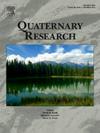塞尔维亚伏伊伏丁那省德利布拉托(巴纳特)沙海北缘最后一次脱冰期的风化动态
IF 1.8
3区 地球科学
Q3 GEOGRAPHY, PHYSICAL
引用次数: 0
摘要
德利布拉托(巴纳特)沙海是欧洲最大的аeolian 沙海之一,位于铁门附近,铁门标志着多瑙河穿过该河最大的峡谷。这里的多瑙河冲积层是巴纳特沙海的沙源,而巴纳特沙海主要是由东南风(科沙瓦风)形成的。本研究采用多代理方法,旨在更好地了解巴纳特沙海的环境动态。为了实现这一目标,我们对代表该沙丘区北部边缘约 20 米厚沙丘层的档案进行了分析。利用光激发发光(OSL)测年法,我们计算出了风化沉积速率和沙丘年龄。沙子大约是在 17 ka 到 13 ka 之间沉积在这里的。通过磁感应强度、粒度和色度分析,对当地的古环境条件进行了解释。计算得出的沉积速率(SR)表明,研究期间的风化沉积强度在 483 厘米/千卡到 502 厘米/千卡之间。我们将我们的数据与地区和其他欧洲档案以及格陵兰冰芯北格陵兰冰芯项目(NGRIP)记录的气候变化进行了比较。本文章由计算机程序翻译,如有差异,请以英文原文为准。
Aeolian dynamics at the northern edge of Deliblato (Banat) Sand Sea, Vojvodina, Serbia, at the time of the last deglaciation
The Deliblato (Banat) Sand Sea, which is one of the largest areas of аeolian sand in Europe, is located near the Iron Gate, which marks the crossing of the Danube River through the biggest gorge of this river. Here, Danubian alluvium has served as the sand source for the Banat Sand Sea, which was formed primarily through southeasterly (Košava) winds. Utilizing a multi-proxy approach, the objective of this study is to gain a better understanding of the environmental dynamics of the Banat Sand Sea. To achieve this goal, we conducted an analysis of an archive representing an approximately 20-m-thick dune formation on the northern edge of this dune field. Using optically stimulated luminescence (OSL) dating, we calculated aeolian sedimentation rates and dune ages. Sand was deposited here approximately between 17 ka and 13 ka. Magnetic susceptibility, grain size, and colorimetric analyses were interpreted in terms of local paleoenvironmental conditions. Calculated sedimentation rates (SR) indicate intensive aeolian deposition during the study period that range from 483 cm/ka to 502 cm/ka. We compared our data with regional and other European archives, as well as with climatic variations recorded in the Greenland ice core North Greenland Ice Core Project (NGRIP).
求助全文
通过发布文献求助,成功后即可免费获取论文全文。
去求助
来源期刊

Quaternary Research
地学-地球科学综合
CiteScore
4.70
自引率
8.70%
发文量
57
审稿时长
3 months
期刊介绍:
Quaternary Research is an international journal devoted to the advancement of the interdisciplinary understanding of the Quaternary Period. We aim to publish articles of broad interest with relevance to more than one discipline, and that constitute a significant new contribution to Quaternary science. The journal’s scope is global, building on its nearly 50-year history in advancing the understanding of earth and human history through interdisciplinary study of the last 2.6 million years.
 求助内容:
求助内容: 应助结果提醒方式:
应助结果提醒方式:


